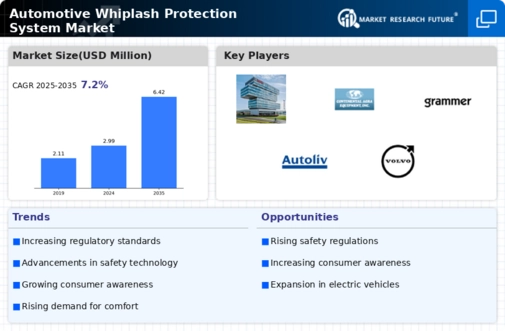Market Analysis
In-depth Analysis of Automotive Whiplash Protection System Market Industry Landscape
The Automotive Whiplash Protection System (WPS) market is influenced by a myriad of market factors that collectively shape its dynamics. One significant driver is the increasing emphasis on occupant safety in automobiles. With a growing awareness of the impact of road accidents on passenger well-being, automotive manufacturers are actively incorporating advanced safety features, including Whiplash Protection Systems, into their vehicles. WPS aims to mitigate the risk of whiplash injuries, particularly in rear-end collisions, by providing additional support to the head and neck region, thereby enhancing overall vehicle safety.
Stringent government regulations and safety standards also play a pivotal role in driving the adoption of Whiplash Protection Systems in automobiles. Governments worldwide are implementing and revising safety standards to ensure that vehicles meet specific crashworthiness criteria. Compliance with these regulations has become a key focus for automakers, prompting the integration of advanced safety technologies like WPS. As these safety standards evolve, the Automotive Whiplash Protection System market responds with continuous innovation and improvements to meet or exceed the established benchmarks.
Consumer preferences and the increasing demand for safer vehicles contribute significantly to the market dynamics of Automotive Whiplash Protection Systems. As consumers become more informed about safety features and prioritize them in their purchasing decisions, automakers are compelled to make safety technologies, including WPS, standard or optional in their vehicle models. The market is witnessing a shift where safety features are no longer considered mere add-ons but essential components contributing to the overall value proposition of a vehicle.
Technological advancements in the field of automotive safety also shape the market factors of Whiplash Protection Systems. The integration of sensors, smart materials, and advanced restraint systems within WPS enhances their effectiveness in real-world scenarios. For instance, the incorporation of intelligent headrests and seat designs that can anticipate and respond to collision forces contributes to the overall efficacy of Whiplash Protection Systems, fostering innovation within the market.
Collaborations and partnerships between automotive manufacturers and technology suppliers are driving advancements in Whiplash Protection Systems. These collaborations leverage the expertise of both parties to develop integrated and sophisticated safety solutions. The synergy between automotive engineering and cutting-edge safety technologies results in the continuous refinement of WPS, ensuring that they not only meet safety standards but also deliver optimal performance in diverse crash scenarios.
The global economic landscape and the automotive industry's overall health also influence the Automotive Whiplash Protection System market. Economic downturns may impact consumer purchasing power and influence the rate at which automakers invest in safety technologies. Conversely, during periods of economic growth, the automotive industry tends to invest more in research and development, leading to the introduction of advanced safety features like WPS.
Competitive factors within the automotive market contribute to the evolution of Whiplash Protection Systems. Automakers strive to differentiate their products by offering superior safety features, and the integration of effective WPS becomes a competitive advantage. This competition fosters innovation, cost-effectiveness, and the widespread adoption of Whiplash Protection Systems across various vehicle segments.
While the market for Automotive Whiplash Protection Systems is generally positive, challenges such as consumer education, cost considerations, and global supply chain disruptions may impact its growth. Raising awareness about the benefits of WPS and addressing cost concerns are essential for widespread adoption, while disruptions in the supply chain may affect the availability and affordability of components necessary for these systems.
The Automotive Whiplash Protection System market is driven by a combination of factors, including safety regulations, consumer preferences, technological advancements, collaborations within the industry, economic conditions, and competitive dynamics. As the automotive landscape continues to evolve, Whiplash Protection Systems play a crucial role in enhancing occupant safety, and their market factors reflect the ongoing commitment to advancing automotive safety technologies for a safer and more secure driving experience.








Leave a Comment